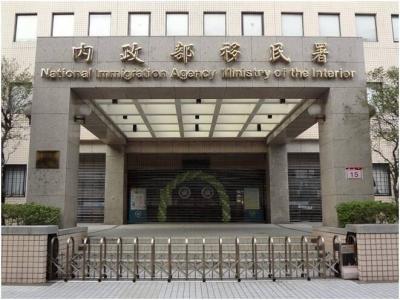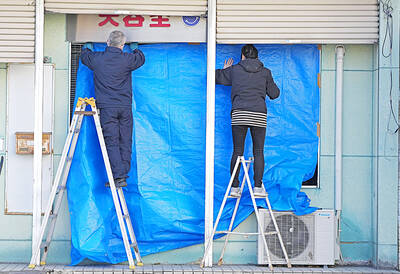The ninth day of Han Kuang exercises continued this morning with forces simulating an enemy advance into the Greater Taipei Area after a successful landing while defending units practiced "hot refueling" of helicopters.
Most of today’s training units are concentrated in Taoyuan and areas north of it, with exercises focusing on testing how combat troops would be able to defend and resist an invading force while also repairing damaged equipment.
The Army’s 601 and 602 Aviation Brigades, in Taichung’s Tungshih District (東勢) and New Taipei City’s Shulin District (樹林) respectively, carried out “hot refueling” drills.

Photo: Lo Kuo Chia, Taipei Times
The drills, featuring two UH-60M Black Hawks and two AH-64E Apache helicopters from the Army's 601 Aviation Brigade, saw the four choppers flying along the Dahan River before stopping at a riverside park in Shulin District.
Throughout the drills, the armed forces have shown off new equipment such as Hsiung Feng III extended-range missiles, US-made FIM-92 Stinger shoulder-fired missiles, and a new scouting drone.
According to the Ministry of National Defense (MND), such a drill involves simultaneously refueling and rearming a military aircraft/helicopter with new munitions while the engines are still running.
This is used to minimize ground time, allowing military aircraft to quickly return to the air during combat operations.
The primary advantage is to significantly reduce the time an aircraft spends on the ground for refueling and rearming, enabling quicker redeployment.
MND said such a practice requires a military aircraft to complete hot-pit refueling and rearming within 30 minutes. This morning's drill was completed in around 20 minutes.
Chieh Chung (揭仲), a researcher at the Association of Strategic Foresight, a Taipei-based think tank, told CNA that today's drill was intended to simulate the Taoyuan-based Army 601 Aviation Brigade being attacked by invading People's Liberation Army (PLA) forces.
Given that their base was under attack, these Army choppers had to turn to other locations for emergency refueling and rearming to maintain their combat readiness, Chieh said.
A similar hot-pit refueling and rearming drill was conducted in central Taichung City, featuring the Army's AH-1W Super Cobra attack helicopters.
Meanwhile, the most prominent urban resilience drills started today at 1.30pm in northern Taiwan, including Taipei, New Taipei, Yilan County, Keelung, Taoyuan and Hsinchu, continuing the same routine from previous exercises in the south and center of the country this week.
At 1.30pm, air raid alarms sounded, with all vehicles required to stop and pedestrians ordered to seek shelter and follow directions from officials.
Public transportation continued to operate, but passengers were not allowed to leave stations.
Fines could range from NT$30,000 to NT$150,000 (US$1,018 to US$5,092) for those failing to comply with directions.
In New Taipei City, police said that their urban resilience command team would go to the Tucheng (土城) District Office, MRT and a supermarket to conduct air defense evacuation and shelter drills.
After the alarm, the team would go to a water plant in Sansia District (三峽) to simulate disaster relief of critical infrastructure.
Tomorrow, the drills are to occur at the same time in Taiwan’s east and outlying islands.
Separately, the MND announced today that from 6am yesterday to 6am today, 58 Chinese aircraft were detected around Taiwan, with 45 crossing the Taiwan Strait’s median line and entering Taiwan’s northern, central, southwestern and eastern air defense identification zones.
Ten Chinese naval vessels were also monitored operating in the strait, it said.
Taiwan’s armed forces “monitored the situation and employed [patrol] aircraft, navy vessels and coastal missile systems in response to the detected activities,” the ministry said.
Additional reporting by CNA, Aaron Tu and Wu Jen-jieh

A small number of Taiwanese this year lost their citizenship rights after traveling in China and obtaining a one-time Chinese passport to cross the border into Russia, a source said today. The people signed up through Chinese travel agencies for tours of neighboring Russia with companies claiming they could obtain Russian visas and fast-track border clearance, the source said on condition of anonymity. The travelers were actually issued one-time-use Chinese passports, they said. Taiwanese are prohibited from holding a Chinese passport or household registration. If found to have a Chinese ID, they may lose their resident status under Article 9-1

Taiwanese were praised for their composure after a video filmed by Taiwanese tourists capturing the moment a magnitude 7.5 earthquake struck Japan’s Aomori Prefecture went viral on social media. The video shows a hotel room shaking violently amid Monday’s quake, with objects falling to the ground. Two Taiwanese began filming with their mobile phones, while two others held the sides of a TV to prevent it from falling. When the shaking stopped, the pair calmly took down the TV and laid it flat on a tatami mat, the video shows. The video also captured the group talking about the safety of their companions bathing

Starting on Jan. 1, YouBike riders must have insurance to use the service, and a six-month trial of NT$5 coupons under certain conditions would be implemented to balance bike shortages, a joint statement from transportation departments across Taipei, New Taipei City and Taoyuan announced yesterday. The rental bike system operator said that coupons would be offered to riders to rent bikes from full stations, for riders who take out an electric-assisted bike from a full station, and for riders who return a bike to an empty station. All riders with YouBike accounts are automatically eligible for the program, and each membership account

A classified Pentagon-produced, multiyear assessment — the Overmatch brief — highlighted unreported Chinese capabilities to destroy US military assets and identified US supply chain choke points, painting a disturbing picture of waning US military might, a New York Times editorial published on Monday said. US Secretary of Defense Pete Hegseth’s comments in November last year that “we lose every time” in Pentagon-conducted war games pitting the US against China further highlighted the uncertainty about the US’ capability to intervene in the event of a Chinese invasion of Taiwan. “It shows the Pentagon’s overreliance on expensive, vulnerable weapons as adversaries field cheap, technologically